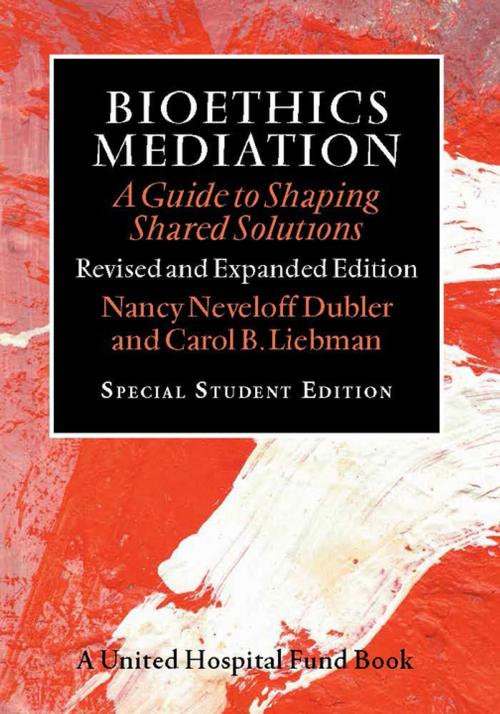Bioethics Mediation
A Guide to Shaping Shared Solutions, Revised and Expanded Edition
Nonfiction, Reference & Language, Law, Medical Law & Legislation, Health & Well Being, Medical, Patient Care, Health Care Delivery, Reference, Ethics| Author: | Nancy Neveloff Dubler, Carol B. Liebman | ISBN: | 9780826519689 |
| Publisher: | Vanderbilt University Press | Publication: | December 1, 2013 |
| Imprint: | Vanderbilt University Press | Language: | English |
| Author: | Nancy Neveloff Dubler, Carol B. Liebman |
| ISBN: | 9780826519689 |
| Publisher: | Vanderbilt University Press |
| Publication: | December 1, 2013 |
| Imprint: | Vanderbilt University Press |
| Language: | English |
Expanded by two-thirds from the 2004 edition, the new edition features two new role plays, a new chapter on how to write chart notes, and a discussion of new understandings of the role of the clinical ethics consultant. **** Bioethics Mediation offers stories about patients, families, and health care providers enmeshed in conflict as they wrestle with decisions about life and death. It provides guidance for those charged with supporting the patient’s traditional and religious commitments and personal wishes. Today’s medical system, without intervention, privileges those within shared cultures of communication and disadvantages those lacking power and position, such as immigrants, the poor, and nonprofessionals. This book gives clinical ethics consultants, palliative care providers, and physicians, nurses, and other medical staff the tools they need to understand and manage conflict while respecting the values of patients and family members. Conflicts come in different guises, and the key to successful resolution is early identification and intervention. Every bioethics mediator needs to be prepared with skills to listen, “level the playing field,” identify individual interests, explore options, and help craft a “principled resolution”—a consensus that identifies a plan aligned with accepted ethical principles, legal stipulations, and moral rules and that charts a clear course of future intervention. The organization of the book makes it ideal for teaching or as a handbook for the practitioner. It includes actual cases, modified to protect the privacy of patients, providers, and institutions; detailed case analyses; tools for step-by-step mediation; techniques for the mediator; sample chart notes; and a set of actual role plays with expert mediator and bioethics commentaries. The role plays include: • discharge planning for a dying patient • an at-risk pregnancy • HIV and postsurgical complications in the ICU • treatment for a dying adolescent • dialysis and multiple systems failure
Expanded by two-thirds from the 2004 edition, the new edition features two new role plays, a new chapter on how to write chart notes, and a discussion of new understandings of the role of the clinical ethics consultant. **** Bioethics Mediation offers stories about patients, families, and health care providers enmeshed in conflict as they wrestle with decisions about life and death. It provides guidance for those charged with supporting the patient’s traditional and religious commitments and personal wishes. Today’s medical system, without intervention, privileges those within shared cultures of communication and disadvantages those lacking power and position, such as immigrants, the poor, and nonprofessionals. This book gives clinical ethics consultants, palliative care providers, and physicians, nurses, and other medical staff the tools they need to understand and manage conflict while respecting the values of patients and family members. Conflicts come in different guises, and the key to successful resolution is early identification and intervention. Every bioethics mediator needs to be prepared with skills to listen, “level the playing field,” identify individual interests, explore options, and help craft a “principled resolution”—a consensus that identifies a plan aligned with accepted ethical principles, legal stipulations, and moral rules and that charts a clear course of future intervention. The organization of the book makes it ideal for teaching or as a handbook for the practitioner. It includes actual cases, modified to protect the privacy of patients, providers, and institutions; detailed case analyses; tools for step-by-step mediation; techniques for the mediator; sample chart notes; and a set of actual role plays with expert mediator and bioethics commentaries. The role plays include: • discharge planning for a dying patient • an at-risk pregnancy • HIV and postsurgical complications in the ICU • treatment for a dying adolescent • dialysis and multiple systems failure















